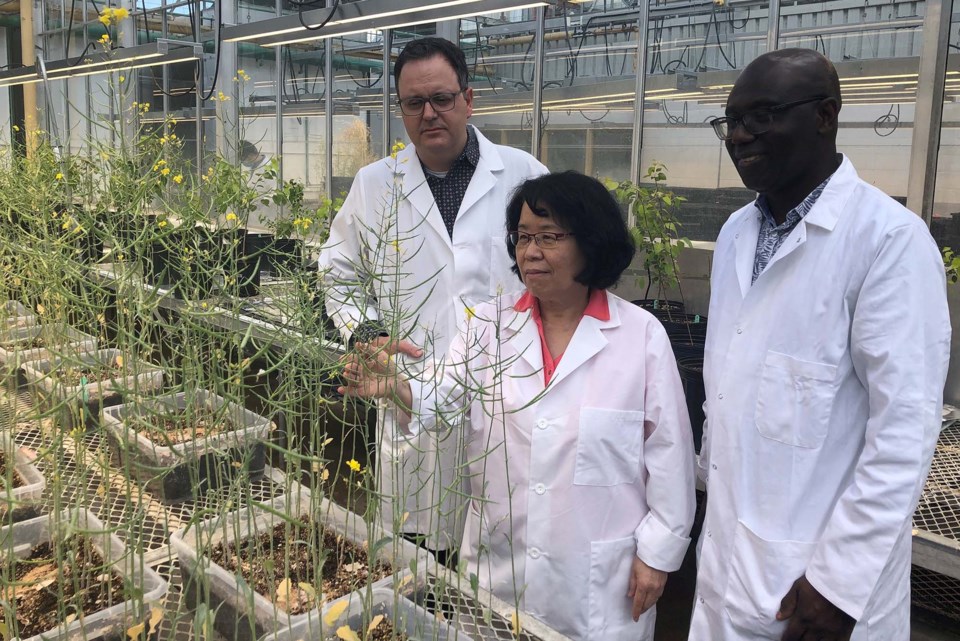It was almost 20 years ago that agronomist Dan Orchard first spotted clubroot in canola in a farmer’s field near St. Albert. It was the first time the disease had been seen in canola in North America.
Just 12 fields in the province had it back in 2003, he recalled, all of them around Sturgeon County. Now, the disease is in thousands of fields province-wide, and is spreading to about 300 more each year, despite widespread use of clubroot-resistant canola.
“The resistance is getting broken,” Orchard said, and that’s a big problem for Alberta farmers.
University of Alberta plant scientist Stephen Strelkov is working on a solution. He’s been studying Alberta’s clubroot problem since 2003, and this summer has started a $1.25 million project with the agriculture company BASF to find new ways to fight off this disease.
Search for solutions
Clubroot is a soil-borne disease of cruciferous vegetables such as canola, cabbage, and broccoli which causes plants to form club-like galls on their roots, sapping their strength. Severe cases can wipe out up to 80 per cent of a canola crop, Alberta Agriculture reports.
Clubroot was initially a huge problem in Alberta as there was no defence against it other than to not grow canola, which was unfeasible for many farmers, Orchard said. Researchers soon developed clubroot-resistant canola, but the disease is now developing new strains which could overcome that resistance.
About 3,500 fields in Alberta now have clubroot, with about 10 per cent of them having strains which could overcome clubroot resistance, Strelkov said.
As part of a five-year project, Strelkov and fellow researchers Sheau-Fang Hwang and Rudolph Fredua-Agyeman, are testing 30 varieties of canola and canola-related crops against clubroot to identify new clubroot-resistant genes and cross-breed them into commercial crops. This will involve growing hundreds of test plants in a greenhouse, and later in test fields to see which fare best against clubroot, then analyzing each to find the genes responsible for the resistance.
Other researchers at the U of A are testing the use of lime against clubroot, Strelkov said. Adding lime to soil raises its pH and makes it less hospitable to clubroot, but researchers have yet to figure out how much lime to use and when to best apply it.
Crop rotation is still a farm’s best defence against clubroot, Strelkov said.
“The pathogen builds up in the soil as spores, and the more canola and canola residue you grow in a field, the more the spores build up.”
Strelkov said farmers should have at least a two-year gap between canola crops in a given field to reduce spore buildup and the risk of new, more virulent strains of clubroot being created.
Bon Accord area farmer Murray Mulligan said his fields definitely have clubroot in them, so he only grows canola (and only clubroot-resistant canola) in any given field once every four years.
“It will adapt,” he said of clubroot.
“That’s why we need to invest money in research to stay ahead of it.”
Orchard and Strelkov emphasized the importance of cleaning dirt off farm equipment to stop this soil-borne disease from spreading. While ideally you want to power-wash and sanitize between fields, most farmers don’t have the time to do so. Still, if you can knock off even 80 per cent of the big chunks of dirt, you can cut about 80 per cent of your transmission risk.
Orchard likened clubroot management to a cake recipe, where every ingredient — resistant crops, long rotations, cleaning equipment, low tillage, and weed control — is essential.
“For every ingredient you leave out, you’re risking your farm further.”
At this point, clubroot is embedded in Alberta’s soils and won’t go away, Strelkov said. Farmers and researchers have to be proactive, watch for new strains of it, and develop new defences.
“We’re in it for the long haul.”




